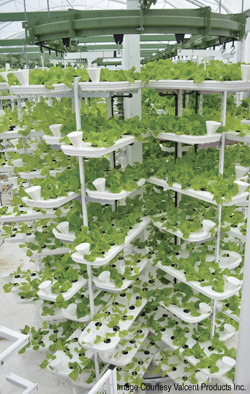Growing Up: Vertical Farming
by Wendy Priesnitz
“The age of the 3,000 mile Caesar salad is coming to an end.” ~ James Howard Kunstler
 Population growth, climate change, peak oil, and looming water shortages are, according to some agricultural researchers, rapidly reducing the amount of usable farmland worldwide. Add to that the trends towards urbanization and local food, and you have a burgeoning urban farming movement, examples of which are regularly covered in this magazine. You also have a recipe for growing up, in which a new generation of urban vertical farmers is involved. Population growth, climate change, peak oil, and looming water shortages are, according to some agricultural researchers, rapidly reducing the amount of usable farmland worldwide. Add to that the trends towards urbanization and local food, and you have a burgeoning urban farming movement, examples of which are regularly covered in this magazine. You also have a recipe for growing up, in which a new generation of urban vertical farmers is involved.
From the hanging gardens of Babylon to trellised veggies growing in small garden plots and “green walls” designed to purify indoor air, people have long enjoyed growing plants vertically. But when we wrote about the phenomenon of vertical farming in Natural Life’s September/October 2006 issue, it was just a dream in the minds of researchers such as Dickson Despommier, a professor at Columbia University’s Department of Environment Health Sciences. But now, vertical farming – although still in its infancy – is taking its place as part of the intensive urban agriculture movement.
If Despommier has his way, food production will be located in high-rise structures and utilize hydroponic or aeroponic (nutrient-laden mist) cultivation systems, which use up to ninety percent less water than conventional techniques. Waste will be recycled and water will be recaptured. As well as conserving water, vertical farming allows for the reclamation of farmland. Despommier estimates that for every indoor acre farmed, ten to twenty outdoor acres of farmland could be allowed to return to their original state – mostly hardwood forest.
While not in a high-rise, vertical farming is being showcased at the Botanical Gardens at the Paignton Zoo Environmental Park in Devon, England. In September of 2009, it opened a high-density vertical farm using technology called VertiCropTM, produced by Valcent Products Inc. The system was chosen by Time magazine as one of the fifty best inventions of 2009. The Curator of Plants and Gardens for the Zoo, Kevin Frediani, says the technology will allow them to grow more plants – fruits, herbs, and leaf vegetables – in less room, using less water and less energy, thereby reducing food miles and their annual bill for animal feed. In addition, a half million visitors a year will be educated about vertical farming.
Chris Bradford is President and CEO of Valcent. He describes the growing system (pictured above) as “trays on a looped dynamic conveyor belt and automatic feeding stations to grow plants efficiently. It can be adapted to the needs of vegetable, herb, fruit, and flower producers.” He says that it can increase production volume for field crops up to twenty times over but requires as little as five percent of the normal water supply and, under proper management, can eliminate the need for pesticides.
Vertical growing systems like VertiCrop are being used in commercial greenhouses in order to maximize the use of space and water. They include large, high-efficiency hydroponic greenhouses throughout England and The Netherlands, and in the Arizona desert. There is also a project in Santa Rosa, California where developer Syamak Taromi found himself in the middle of a housing crisis with ten acres destined for a seniors’ housing facility. Instead, his son and a friend used some old greenhouses on the site to create a sustainable urban agriculture company selling lettuce and herbs at local farm markets and to local restaurants; they hope to expand into San Francisco and integrate vertical farming into apartment buildings.
Stacking these vertical growing systems on top of each other in high-rise buildings presents engineering challenges. And critics say such farms would be prohibitively energy-intensive and therefore expensive and unsustainable. Nevertheless, that’s the idea behind Dickson Despommier’s vertical farm concept: a thirty-story crop powerhouse the size of a Manhattan block that he says could produce enough food for fifty thousand people. Despommier recently told the media that constructing a five-story farm, taking up one-eighth of a square city block, would cost twenty to thirty million dollars. At least one New York bureaucrat has expressed interest in creating a pilot project in that city.
Although there are proposals for high rise farms in a variety of cities, and no lack of futuristic looking architectural drawings, it seems fitting that perhaps the most interest has been generated in the Middle East, specifically in Dubai, home of the world’s tallest building. In January of 2010, Valcent Products presented its vertical farming system at The Dubai Forum: “Architecture for Sustainable Societies,” marking the opening of the Burj Dubai skyscraper. So, if you live in a large city, the days are definitely numbered for that 3,000-mile Caesar salad.
Wendy Priesnitz is the editor and co-founder of Natural Life Magazine. A journalist with over 40 years of experience, she is also the author of 13 books.
|

